Death Valley - hottest, driest & lowest
- tangynotes
- Feb 4, 2022
- 4 min read
Our second leg of the twin trip to southern California was the visit to Death Valley National Park.
Death Valley is the hottest, driest, and lowest national park in the USA. It’s also one of the hottest places on Earth (it gets to a blistering 120°F in the summer). And this heat is no joke — it’s called Death Valley for a reason.
The park is a land of extremes and contrasts – there are salt flats, sand dunes, and even canyons to explore. Pastel-covered mountains and beautiful creeks. It’s weird and wild, and a great place for adventurers — as long as it’s not summer. It is one of the places if you’re looking to escape the cold.
The landscape in DVNP is hard to believe.
Death Valley National Park is located in southeastern California, bordering the state of Nevada. It’s actually not too far from — only 2 hours away!
There are two main routes to choose from when driving from Las Vegas to Death Valley:
· Pahrump and Death Valley Junction (via NV-160)
· Indian Springs and Amargosa Valley (via US-95)
Death Valley can be covered in one or two days depending on how much you want to cover. I’ve heard of people staying a week or longer if they want to explore further afield — like The Racetrack and/or Ubehebe Crater.
The best time to see Death Valley is Winter or Fall. SKIP THE SUMMER. Don’t even attempt a visit — you’ll be unbearably miserable. One negative of a winter visit is the fact that daylight hours are so much shorter (the sunset around 4:30 pm in December when we were there). Make sure to get an early start if you truly want to maximize your time.
We started our drive towards Death Valley around 5 am and planned to be there for sunrise. Our stops in DVNP were in the following order so you can follow this exact itinerary to maximize your time. Make sure to load up on the gas, pack enough lunch and snacks for the day, and DO NOT MISS THE WATER.
7: 15 am Dante’s View: Driving up the windy, curvy roads to Dante’s View was the first stip. From up here at 5,476 feet, you can see Badwater Basin and Telescope Peak. The 360° views in every direction are absolutely spectacular.
7: 45 am Twenty Mule Team This isn’t an actual hike in Death Valley, but a beautiful drive along an unpaved road through colorful, eroded badlands. If you’re looking for the best light, drive the ~2.5miles (one way) in the early morning or late afternoon. But beware this trail was closed for us because of flooding.
8: 30 am Zabriskie Point: Colorful badlands and rock formations do! Makes sense – Zabriskie Point is one of the most popular things to do in Death Valley. After a short uphill walk on a paved path, you reach a scenic overlook with unobstructed 360° degrees from the top.
9: 00 am Golden Canyon trailhead: Out of all the things to do in Death Valley, we really enjoyed the few short hikes we went on! We didn’t tackle anything strenuous and kept our walks/hikes to around 2-3 miles. This was such a fun hike! From the trailhead, there are a few different hikes you can choose from, ranging from short, easy strolls to strenuous adventures. We hiked to the Red Cathedral, for a total of ~3 miles roundtrip. It was the perfect amount of time for a moderate mid-afternoon hike in the shade.
11:00 am Furnace Creek: This is the visitor center with a vending machine, maps, and other info you need. Fun Fact — the badlands are made of sediments from Furnace Creek Lake which dried up 5 million years ago – whoa!
11: 45 am Badwater Basin Salt Flats: Lowest, driest and hottest point in North America at 282 feet below sea level! This was a unique experience to see the sal bed after walking about 1.5 miles. we stopped there and ate our packed lunch.
1: 30 pm Devils Golf Course: This area of Death Valley definitely looks the most hellish — there are jagged spires, large stalagmites, and spiky mounds covering the ground. Be extra careful walking around – the ground is super sharp.
2: 45 pm Artists Drive and Artists Palette: Artists Drive is easily one of the most unique things to do in Death Valley, featuring natural pastel colors on the canyons (everything from blue and purple and green). A geologist’s true paradise with it’s multi-colored mineral rocks and canyons!
At about 5 miles in, you’ll reach Artist Palette — the main attraction of Artists Drive! Get out, soak it all in, take photos of the multi-colored canyons, and possibly hike down closer (we stayed at the top).
4: 00 pm Mesquite Flat Sand Dunes near Stovepipe Wells: Sculpted sand dunes as far as the eye can see. Long-curving shadows. And mountains on the horizon. We took a guided tour in sand dunes to understand the geology and biodiversity of this amazing place. The Mesquite Flat Sand Dunes are the largest dune field in Death Valley, so there’s lots and lots to explore. The guided tour gave us such interesting scientific facts about why there was the desert in place which was once a lake. if you have more interest in finding that do not forget to send a message to us.
Do not delay this trip, Death Valley is amazing!











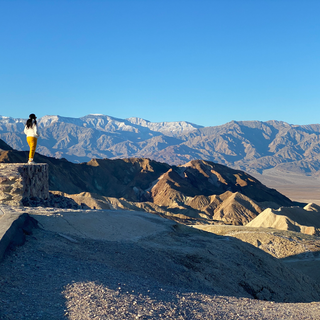
























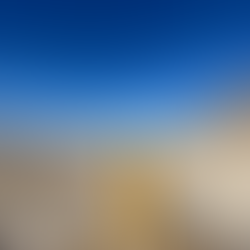


















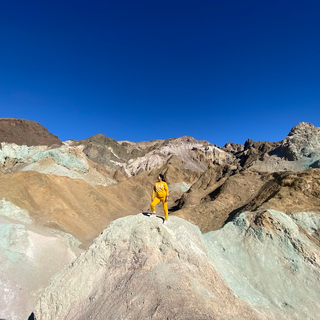

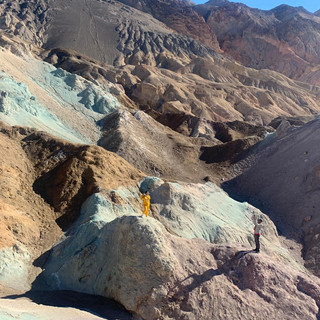











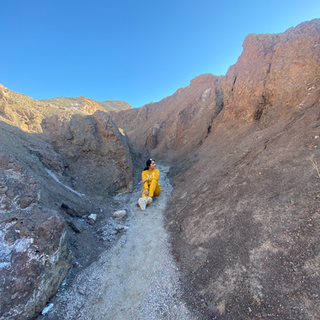















Pretty pretty.. your blogs are a perfect reference to every detail for the place.. love the way you sequence and mention everything..👍🏻
I love every shot you have captured and specially with the one where the sand I dropping through your hand.. Not yo mention about your styling, it's on point as always..❣️